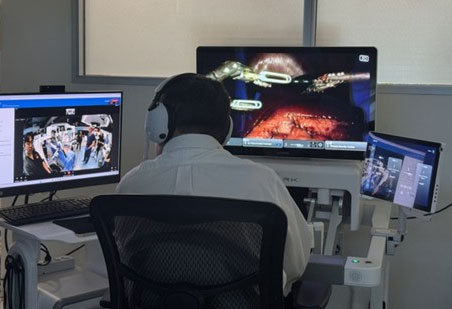
Remote Revolution - Telesurgery Poised to Reshape $14 Billion Robotic Surgery Market
Remote Revolution: Telesurgery Poised to Reshape $14 Billion Robotic Surgery Market
LivsMed's STARK System Signals New Era of Accessible Remote Surgical Innovation
In a nondescript laboratory in Chicago, a groundbreaking surgery took place on July 1st. The surgeon's hands, however, were 2,000 miles away in Santa Barbara, California.
This wasn't science fiction, but the debut of STARK™, a new "telesurgery-native" robotic system developed by LivsMed in partnership with Sovato. The demonstration—where surgeons remotely performed complex procedures including cholecystectomy and partial liver resection on a porcine model—represents more than just technological showmanship. It signals a potential inflection point in a rapidly evolving market that industry observers believe could fundamentally reshape surgical care delivery worldwide.

The $55 Billion Question: How Remote Surgery Changes Everything
The global robotic surgery market currently stands at approximately $13.79 billion and is projected to quadruple to $54.66 billion by 2034, growing at a blistering 16.5% compound annual rate. Within this broader ecosystem, the remote surgery technology segment—valued at $2.49 billion in 2024—is forecast to reach $10.52 billion by 2034.
"We're witnessing the democratization of surgical expertise," notes a healthcare technology analyst who tracks medical device innovations. "The historical model required either patient travel to centers of excellence or surgeon travel to underserved regions. Telesurgery fundamentally disrupts that paradigm."
This disruption comes at a critical juncture. Over half the world's population lacks access to high-quality surgical care, and even developed nations face mounting challenges. The United States alone confronts a projected shortfall of up to 30,200 surgeons by 2034—a gap that conventional approaches cannot bridge.
Breaking the Price-Performance Barrier
Traditional robotic surgery systems have delivered measurable clinical benefits but at prohibitive costs. The dominant incumbent, Intuitive Surgical's da Vinci platform, commands approximately 80% market share but requires capital investments exceeding $2 million per unit, plus significant per-procedure costs.
STARK's approach leverages LivsMed's existing ArtiSential® handheld instruments, known for providing up to 90° articulation at substantially lower costs than traditional robotic systems. By embedding remote capabilities directly into the platform architecture rather than as an afterthought, STARK addresses key technical hurdles that have historically limited telesurgery adoption.
"The industry has long struggled with three fundamental challenges: network reliability, seamless workflow integration, and cost structures that make sense for healthcare economics," explains a medical robotics consultant who has advised several major healthcare systems. "Any solution that meaningfully addresses all three simultaneously deserves serious attention from both providers and investors."
Investment Landscape: Where Smart Money Might Flow
The competitive terrain in robotic surgery is increasingly dynamic. While Intuitive Surgical maintains dominant market position, emerging challengers are advancing rapidly. Medtronic's Hugo and Johnson & Johnson's Ottava systems emphasize modular, open-architecture designs, while CMR Surgical's Versius offers a compact, multi-arm approach.
For investors analyzing this space, several key metrics warrant close attention:
-
Regulatory Pathway Clarity: Companies demonstrating clear strategies for navigating FDA and international approvals may command premium valuations.
-
Cost-Per-Procedure Economics: Systems delivering measurable clinical benefits while reducing per-case costs represent particularly compelling opportunities.
-
Network Effect Potential: Platforms that create defensible ecosystems connecting surgeons, facilities, and patients could establish powerful competitive moats.
-
Geographic Expansion Strategy: Asia-Pacific markets present extraordinary growth potential given rising healthcare investments and acute surgeon shortages.
"The winners in this space won't necessarily be those with the most advanced hardware," suggests a healthcare-focused private equity partner. "Success will likely hinge on creating integrated solutions that solve real-world healthcare delivery problems while generating attractive unit economics."
The Telehealth Integration Wildcard
Perhaps the most intriguing aspect of telesurgery's market potential lies in its natural convergence with broader telehealth platforms. The COVID-19 pandemic accelerated telehealth adoption dramatically, with infrastructure investments that could potentially support telesurgery expansion.
"We're seeing healthcare systems that previously viewed telehealth and surgical robotics as entirely separate initiatives now recognizing substantial strategic synergies," observes a hospital administrator who recently oversaw a major robotics program expansion. "The facilities that successfully integrate these capabilities may enjoy significant competitive advantages in both patient acquisition and specialist retention."
A Market Inflection Point with Cautious Optimism
For investors evaluating this sector, the convergence of multiple tailwinds—technological maturation, healthcare workforce challenges, regulatory evolution, and telehealth infrastructure—suggests potential for accelerated growth. However, significant execution risks remain, particularly regarding clinical validation, reimbursement pathways, and network reliability.
Companies like LivsMed that simultaneously address affordability and remote capabilities appear well-positioned, but incumbent giants possess formidable resources to develop their own integrated solutions. The next 12-24 months may prove decisive as early commercial deployments generate real-world performance data.
"We're approaching the steep part of the adoption curve," predicts a medical technology forecaster. "The systems demonstrating consistent outcomes across varying network conditions while maintaining favorable economics will likely capture disproportionate market share."
Investment Considerations: Looking Ahead
Investors considering exposure to this sector should carefully evaluate several factors beyond traditional financial metrics. Robust clinical validation data, strategic partnerships with healthcare networks, and scalable connectivity solutions may prove particularly valuable indicators of future success.
Market participants should also closely monitor regulatory developments, as frameworks governing telesurgery continue to evolve rapidly across jurisdictions. Companies demonstrating proactive regulatory engagement may mitigate significant commercialization risks.
As with any emerging healthcare technology, past performance cannot guarantee future results, and consultation with specialized financial advisors is recommended before making investment decisions in this complex, rapidly-evolving sector.
What remains clear is that telesurgery no longer represents a theoretical future state. With demonstrations like STARK's cross-country procedure, the question has shifted from whether remote surgery will become viable to how quickly it will transform the standard of care—and which companies will lead this transformation.
NOT INVESTMENT ADVICE